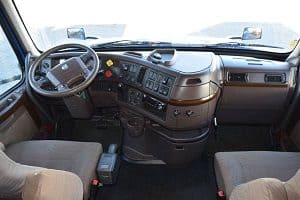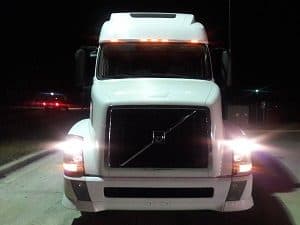 Yes, truck drivers do have to wear seat belts. As a matter of fact, all CMV (commercial motor vehicle) drivers have to wear a seat belt in order to operate the vehicle. Whether you are transporting property with a truck or transporting passengers with a bus you have to (the driver) wear your seat belt at all times.
Yes, truck drivers do have to wear seat belts. As a matter of fact, all CMV (commercial motor vehicle) drivers have to wear a seat belt in order to operate the vehicle. Whether you are transporting property with a truck or transporting passengers with a bus you have to (the driver) wear your seat belt at all times.
What about commercial vehicle passengers? Passengers in all property carrying commercial vehicles have to be wearing a seat belt properly at all times as well (as of 2016).
For example, if you are team driving or if you have a passenger (for any reason) sitting
in your passenger seat they must wear a seat belt.
Does the law include bus passengers? No.The only exception are passengers on large passenger buses. On large buses passengers are not required to wear seat belts, only the driver of the bus is.
Seat Belt Laws For Commercial Vehicles
Federal seat belt laws for commercial drivers and passengers of property carrying commercial vehicles is the following (Source FMCSA):
No driver shall operate a commercial motor vehicle, and a motor carrier shall not require or permit a driver to operate a commercial motor vehicle, that has a seat belt assembly installed at the driver’s seat unless the driver is properly restrained by the seat belt assembly.
Also, the FMCSA states that every truck and truck tractor manufactured on or after July 1, 1971 must have seat belts installed in them by the manufacturer.
What is the intent of the FMCSA? Their intent is simple: To increase the safety, not only of passengers, but also of CMV drivers whose control of the vehicle could otherwise be affected by unsecured passengers potentially thrown about the cab as a result of emergency steering or braking maneuvers.
Is the driver responsible for passengers? Yes, to an extent. It is the responsibility of the driver to make sure that passengers are wearing their seat belts before driving.
All passengers on a property-carrying CMV have to wear a seat belt. Here is what the law is regarding passengers in commercial motor vehicles:
No driver shall operate a property-carrying commercial motor vehicle, and a motor carrier shall not require or permit a driver to operate a property-carrying commercial motor vehicle, that has seat belt assemblies installed at the seats for other occupants of the vehicle unless all other occupants are properly restrained by such seat belt assemblies.
There is an exception though. The exception says that the driver does not need to continuously monitor the passenger(s) while the vehicle is in operation.
The driver is responsible for checking whether or not passengers secure the seat belt before operating the vehicle and should remind passengers that they are required to use a seat belt during the trip.
The Motor Carrier Act Of 1935 And The Motor Carrier Safety Act Of 1984
The law regarding truck driver seat belts stems from the Motor Carrier Act of 1935 and the Motor Carrier Safety Act of 1984.
The 1935 Act authorizes the FMCSA to prescribe requirements for the safety of operation and equipment standards of motor carriers.
The 1984 Act requires the FMCSA to adopt regulations to ensure that commercial vehicles are maintained, equipped, loaded, and operated safely.
This seat belt law will increase safety of CMV drivers (and passengers) of commercial vehicles.
Sleeper Berth Seat Belt Law For Trucks
What about sleeper berths? Yes, sleeper berths are also addressed in the seat belt laws (source):
“A motor vehicle manufactured on or after July 1, 1971, and equipped with a sleeper berth must be equipped with a means of preventing ejection of the occupant of the sleeper berth during deceleration of the vehicle. The restraint system must be designed, installed, and maintained to withstand a minimum total force of 6,000 pounds applied toward the front of the vehicle and parallel to the longitudinal axis of the vehicle.”
If you are team driving and one of you are sleeping in the sleeper berth you do have to have the restraint engaged.
Seat Belt Safety for truck Drivers: Why Is It Necessary?
Wearing a seat belt has a lot of benefits. Here are the reasons aside from worrying about receiving a citation why you should always wear your seat belt.

1. They Save Lives: Wearing a seat belt prevents your body from moving in the event of a crash or emergency stop.
Think about it, if you are in an accident your truck will stop moving but whatever in the truck is not belted to the truck will continue moving forward.
Unfortunately, it’s often the windshield or roadway that is the object that stops your forward motion.
Wear your seat belt so that the object stopping your motion isn’t your windshield.
2. They Keep You Behind The Wheel: If there is an accident you might lose control of your truck because you don’t have a seat belt on to help hold you in place.
Wearing your seat belt holds you in place so that you could steer your way out of danger.
3. Your Family: If you do have loved ones waiting for you at home then wear the seat belt for them. If you tell your children to wear their seat belts then you need to wear yours too! Lead by example!
Seat Belt Safety Myths
In an effort to put drivers at ease the FMCSA has addressed some common myths regarding seat belts and wearing them. (Source: FMCSA)
Myth 1: Seat Belts Are Uncomfortable and Restrict Movement
Seat belts that are uncomfortable needs to be properly adjusted. If your seat belt is restricting your movement then make sure you adjust your lap and shoulder belt so that wearing the seat belt is more comfortable.
Myth 2: It’s Better To Be Thrown Clear Of The Wreckage In The Event Of A Crash
In 2006, 217 truck occupants and drivers were killed then they were ejected form their cabs during crash. You are four times more likely to be killed if you are ejected from
the vehicle during an accident/crash.
Myth 3: Safety Belts Are Not Necessary: The Large Truck Will Protect You
In 2006, 805 drivers and occupants of large trucks died in crashes and 393 were not wearing seat belts. If you are in an accident the chances of surviving it are much greater if you are wearing a seat belt.
Myth 4: Wearing A Seat Belt Is A Personal Decision
It is a personal decision, but the current law is such that all commercial vehicle drivers are required to wear a seat belt. If you are caught not wearing a seat belt you will receive a violation
and you are risking your health/life.
Myth 5. It Takes Too Much Time To Put On A Seat Belt
Putting your seat belt on takes about three seconds.
Myth 6: Seat Belts Are Not Needed If You Are Not Going Fast
If a collision at 30 miles per hour a person that is not wearing a seat belt is going to continue moving forward at 30mph until another object/forces stops them.
Guess what that force is? Unfortunately it is going to be the dashboard, your windshield, or the road if you get ejected.
Myth 7: Seat Belts Will Prevent You From Escaping A Burning Or Submerged Vehicle
The odds of a fire or being submerged in water is low. The seat belt can prevent you from hitting your head and being knocked unconscious.
Myth 8: Good Truck Drivers Don’t Wear Seat Belts
Accidents can occur to anybody, good and bad drivers. A lot times you may not be the cause of the accident but cannot prevent it. Having the seat belt on is the best way to protect yourself from being ejected of hitting your head.
Myth 9: A Lap Belt Offers Sufficient Protection
Wrong. The lap and shoulder belt are designed to hold you securely in place.
What Can Carriers Do To Make Sure Drivers Are Buckling Up?
Carriers can do a lot to make sure their drivers are wearing their seat belts. Among the things that carriers are doing include the following:
1. Committing to driver safety programs.
2. Enforcing and establishing driver safety policies.
3. Involving drivers in how to to put seat belt programs in place.
4. Promoting seat belt use in training and safety meetings.
5. Addressing factors that lead to crashes, such as distracted driving.